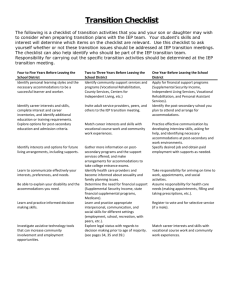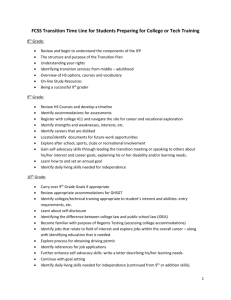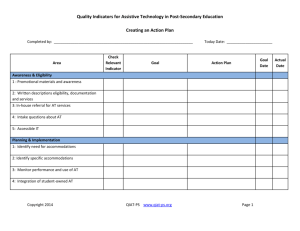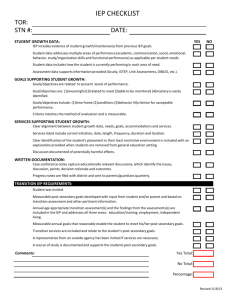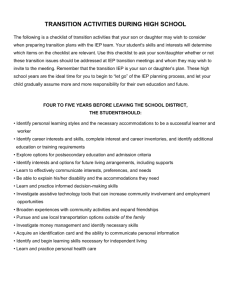IEP Writing Cheat Sheet
advertisement
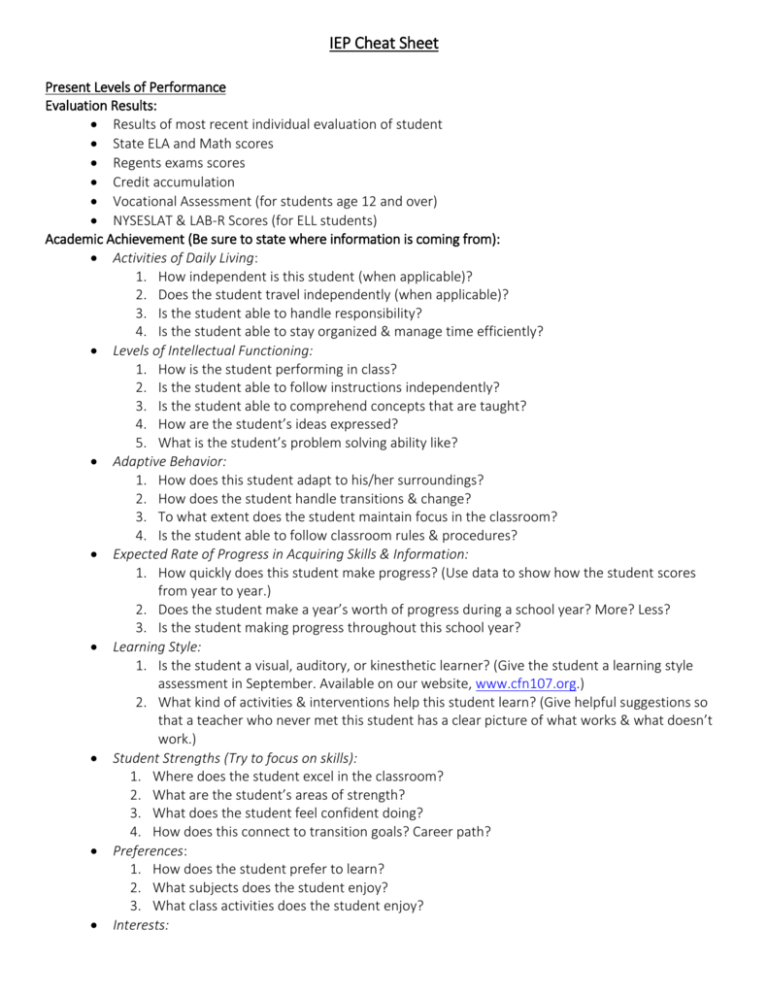
IEP Cheat Sheet Present Levels of Performance Evaluation Results: Results of most recent individual evaluation of student State ELA and Math scores Regents exams scores Credit accumulation Vocational Assessment (for students age 12 and over) NYSESLAT & LAB-R Scores (for ELL students) Academic Achievement (Be sure to state where information is coming from): Activities of Daily Living: 1. How independent is this student (when applicable)? 2. Does the student travel independently (when applicable)? 3. Is the student able to handle responsibility? 4. Is the student able to stay organized & manage time efficiently? Levels of Intellectual Functioning: 1. How is the student performing in class? 2. Is the student able to follow instructions independently? 3. Is the student able to comprehend concepts that are taught? 4. How are the student’s ideas expressed? 5. What is the student’s problem solving ability like? Adaptive Behavior: 1. How does this student adapt to his/her surroundings? 2. How does the student handle transitions & change? 3. To what extent does the student maintain focus in the classroom? 4. Is the student able to follow classroom rules & procedures? Expected Rate of Progress in Acquiring Skills & Information: 1. How quickly does this student make progress? (Use data to show how the student scores from year to year.) 2. Does the student make a year’s worth of progress during a school year? More? Less? 3. Is the student making progress throughout this school year? Learning Style: 1. Is the student a visual, auditory, or kinesthetic learner? (Give the student a learning style assessment in September. Available on our website, www.cfn107.org.) 2. What kind of activities & interventions help this student learn? (Give helpful suggestions so that a teacher who never met this student has a clear picture of what works & what doesn’t work.) Student Strengths (Try to focus on skills): 1. Where does the student excel in the classroom? 2. What are the student’s areas of strength? 3. What does the student feel confident doing? 4. How does this connect to transition goals? Career path? Preferences: 1. How does the student prefer to learn? 2. What subjects does the student enjoy? 3. What class activities does the student enjoy? Interests: 1. What does the student enjoy (academic/social interests, hobbies, etc.) Give the student an interest inventory to get more information in this area. Interest inventories can be found on the Internet. 2. How does this connect to transitional/career goals (Be sure to include the results of the Level I Vocational Assessment again)? Academic, Developmental, & Functional Needs Including Concerns of the Parent: 1. What does the student need in order to be successful? 2. What interventions have worked with this student? 3. What accommodations & modifications have worked for this student? 4. What supports or services have been effective? 5. Be sure to include input from the student & the parent in every section of Academic Achievement, but especially in this one. Social Development (Be sure to state where information is coming from) For students receiving counseling, this section should be completed thoroughly by the counselor: The Degree & Quality of Student’s Relationship with Peers & Adults, Feelings About Self, & Social Adjustment to School & Community Environments: 1. How does this student behave in the classroom? 2. How does the student relate to adults? To peers? 3. How does this student handle stress? 4. How is this student’s etiquette? 5. How does this student present him/herself? Student Strengths: 1. In what ways does this student excel socially? 2. In what ways does this student show confidence in social situations? 3. How does this connect to transitional/career goals? Social Developmental Needs of the Student Including Concerns of the Parent: 1. What are some needs of the student socially? 2. What interventions have worked with this student? 3. What supports or services have been effective? 4. Be sure to include input from the student & the parent in every section of Social Development, but especially in this one. Physical Development (Be sure to state where information is coming from) For students receiving OT, PT, and/or Hearing Services, this section should be completed thoroughly by the provider: The Degree & Quality of the Student’s Motor & Sensory Development, Health, Vitality, & Physical Skills or Limitations Which Pertain to the Learning Process: 1. How are this student’s motor skills? 2. What is the quality of this student’s handwriting (if appropriate)? 3. Are there any physical limitations? 4. Does the student have mobility problems? Student Strengths: 1. In what ways does this student excel physically? 2. Is the student athletic? 3. Does the student participate on any school or community athletic teams? 4. How does this connect to transitional/career goals? *Note: If having trouble filling out this section, speak to the student’s Phys. Ed teacher. Physical Development Needs of the Student: 1. What are some needs of the student physically? 2. What interventions have worked with this student? 3. What supports have been effective? 4. Be sure to include input from the student & the parent in every section of Physical Development, but especially in this one. Management Needs: Material Resources: (e.g. instructional material such as graphic organizers, checklists, vocabulary cues, translation, images, books on tape, etc.) Environmental Resources: (e.g. consistency in routine, limited auditory & visual distractions, adaptive furniture, etc.) Human Resources: (e.g. organizational systems, note-taking assistance, help getting to classes, positive behavior reminders, etc.) Note: Paras are not indicated in this section. Note: It is helpful to put common strategies that are useful based on the student’s learning style. Effects of Student Needs on Involvement in General Education Curriculum: How does the student’s disability affect his or her involvement or success in general educations? Write: The student can participate in the general education curriculum with special education support services. (This statement should not be used for students who are designated as NYSAA). *NOTE: All sections and subsections of PLOP must be completed. An “N/A” or “Not Applicable” is not acceptable in any of the above sections. Student Needs Relating to Special Factors: Be sure that all questions and sub-questions are answered. If a question does not apply to a student, do not leave it blank, check “Not Applicable”. Measurable Post-Secondary Goals *This section MUST be completed for any student age 15 or older. If a student will be turning 15 during the period of the IEP, this must be completed. This is based on the Vocational Assessments. Education/Training: What type of institution will the student attend after high school & what will he or she study? Fill in the sentence: “_________ will attend a _________ and study _____.” Employment: What will the student do for a living? Fill in the sentence: “________ will be employed in the field of ___________.” Independent Living Skills: What will the student need to be able to do that he or she cannot do now in order to live independently after leaving high school? Transition Needs: What courses will the student need to take in order to prepare to meet these goals? So, for example, if the student will be attending college, write the courses and exams that the student will need to take in high school to graduate. Also, any college prep courses that the student will take should be listed. Then, list what courses the student will be taking to prepare for the field of study that he/she plans to follow. Note: This section does not need to be written as a narrative and can be bulleted. Measurable Annual Goals Annual Goals: Goals should be appropriate for the student’s abilities and should address the needs identified in the PLOP. The goals should be SMART. Be sure that each goal is realistic for the student to complete within the year that this IEP will be in effect. Criteria: The criteria for each goal must include a percentage of accuracy as well as the number of trials. (i.e., 80% accuracy in 4 out of 6 trials) Method: In this column you should list all of the possible methods of assessing the progress towards the goal. (i.e., checklists, classroom observations, exams, homework, etc.) Schedule: How often will you be measuring progress on this specific goal. (i.e., once a semester, twice a month, weekly, etc.) Short-Term Instructional Objectives should only be completed for New York State Alternate Assessment (NYSAA) students. Reporting Progress to Parents Progress reports should be sent to parents at the same time report cards are given. Recommended Special Education Programs & Services *NOTE: For any item specified, each field must be completed, otherwise the IEP will not migrate into CAP and the IEP will be Out of Compliance. Special Education Program: Specify which Special Education program(s) (i.e. Special Class, ICT, SETSS) the student will be utilizing. If the student will be in ICT 4 periods of the day, you must list ICT 4 times and for each one identify the subject. It is assumed that for any subject not listed in this section, the student is in general education. Related Services: Specify which Related Service(s) (i.e. counseling, OT, PT, speech, vision, etc.) the student needs. For a group of 8, choose “group service”. For a group size of 2-7, choose “other”, then select the number of students in the group. Supplementary Aids & Services/Program Modifications/Accommodations: (i.e. paraprofessional, orientation/mobility teacher, note-taker, instructional material in alternate formats [i.e. Braille], extra time to go between classes, etc.) Assistive Technology Devices &/or Services: Any assistive technology that the student utilizes during the school day &/or at home. Be sure to complete all fields including “location”. Supports for School Personnel on Behalf of the Student: Anything that the staff members will need in order to assist the student. This is not a direct service for the student (i.e. information on a specific disability & implications for instruction, training on specific positive behavioral interventions, training on assistive technology devices, assistance with curriculum modifications, etc.). 12-Month Service and/or Program Will the student be receiving services during the summer months? If yes, be sure to complete the rest of the section answering all questions and completing all fields. Testing Accommodations If the student does not have any testing accommodations, be sure to check the “none” box. Testing Accommodations: Select the testing accommodations that this student needs, based on areas identified as needs in the PLOP. Conditions: Describe the type, length, purpose of test for which the student should receive the specified accommodation. Implementation Recommendations: Make the accommodation more specific by explaining how this accommodation should be carried out. (i.e. amount of extended time, type of setting for a special location, etc.). Coordinated Set of Transition Activities This whole section should align with the Measurable Post-Secondary Goals section including Transition Needs. Instruction: Identify any instruction the student might need in order to prepare for post-school living. This could include courses and skill areas. This should connect to the Transition Needs section of the Measurable Post-Secondary Goals. Related Services: If a student receives any related service, the student needs to receive transition support to attain the projected post-secondary outcomes. The service should not just be listed, for example, “Speech”, but instead the speech teacher should explain what the transition activities are that he or she will be working on with the student in order to prepare to meet the post-secondary goals. Community Experiences: Any community based experiences the student needs to achieve his or her projected post-secondary outcomes. For example, after school jobs, use of a library, community recreational activities, volunteering opportunities. Note that any job the student holds should not be listed unless it relates in some way to the post-secondary goals. Development of Employment & Other Post-School Adult Living Objectives: Any skills the student needs in order to live independently and be employed. For example, budgeting, opening a bank account, writing a resume & cover letter, going on a job interview. These should only be included if a deficit in these areas was identified in the PLOP. Acquisition of Daily Living Skills (if applicable): If appropriate to the needs of the student, the IEP must indicate the services or activities that will assist the student in activities of daily living skills (e.g., dressing, hygiene, self-care skills, self-medication). Functional Vocational Assessment (if applicable): The IEP must indicate if the student will need a functional vocational assessment as a transition service or activity. A functional vocational assessment is an assessment to determine a student’s strengths, abilities and needs in an actual or simulated work setting or in real work sample experiences. Note: This is most often used with NYSAA students. Participate in State & District-Wide Assessments The first checkbox should be selected for all students other than NYSAA students. For NYSAA students, check the second box and then identify that the student is a NYSAA student and completes datafolios. Be sure to explain why the student cannot participate in the general assessment and why NYSAA is appropriate for this particular student. The determination that a student will be eligible for NYSAA cannot be done at an annual review. A psychologist must make this determination based on evaluations. Special Transportation Select “None” for a student who does not need special transportation. Select “Student Needs Special Transportation Accommodations” for students who need this service. If this is selected, you must specify what type of transportation or accommodations the student requires.


